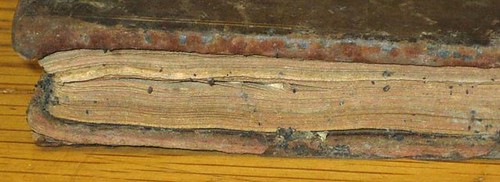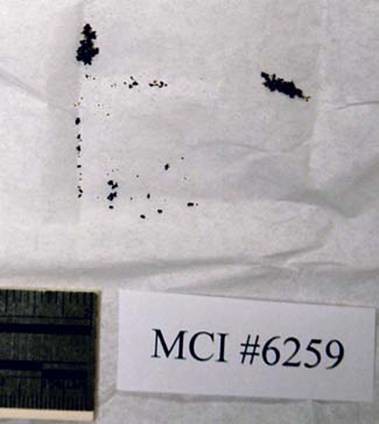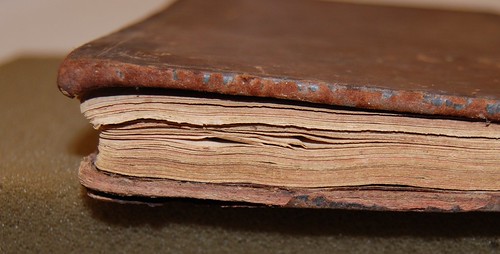In the spring, the Libraries' Book Conservation Lab was contacted by Lilla Vekerdy and Kirsten van der Veen of the Dibner Library regarding a recent donation. The 1775 book, A Father's Legacy to his Daughters, by John Gregory, recently came to the Dibner as part of a donation and had particular trouble. There were traces of mold and evidence of insect damage, usually identifiable by loss to paper, wood, and leather. However, this object was also noticeably infected with the resulting insect frass (excrement). While some areas of the leather covers had been eaten away by the offending insects, the pages were stained yellow and black from insect droppings. This was principally along the longitudinal edges of the pages. As a result, leaves could not lie flat due to distortion by the volume of frass. Clearly, the book proved a suitable rest stop to unwelcome guests (top two images, below).
Turning to our conservation colleagues at the Smithsonian Museum Conservation Institute (MCI) in Suitland, Md., I contacted Mary Ballard, Senior Textile Conservator. Luckily for the Libraries, she is licensed for research, demonstration, and fumigation in the state of Maryland—and was more than willing to assist us.
The book was sent directly to Suitland for treatment. According to Ballard and MCI conservator Nicole Little the debris was characteristic of cockroaches and other insects, including areas of dark gray residue that was often attached to the book's edges by means of white adhesive webs. The spherical dark black frass rolled off fairly easily and did not have an adhesive power. This suggests that the frass was old and desiccated. Under the direction of Ballard, the book was bagged and contained in anoxic (low oxygen) conditions in an argon atmosphere below 1% oxygen for nineteen days. After measurement of the oxygen content, the laminate bag containing the book was resealed; the book was left in this state until surface cleaning could begin. Finally, the book was vacuumed on the exterior and interior, page by page, by Ballard. All frass and loose debris were removed (bottom two images, below).
The results were impressive, as was the expertise available from the conservation resources within the Institution. This is a great example of the Smithsonian community’s cooperation for the greater good of the collections. I'm happy to report that the book is in a new enclosure and on its way back to the Dibner for cataloging.—Vanessa Haight Smith





Be First to Comment